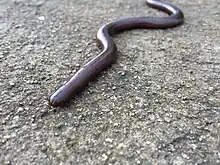| Argyrophis diardii | |
|---|---|
 | |
| Scientific classification | |
| Domain: | Eukaryota |
| Kingdom: | Animalia |
| Phylum: | Chordata |
| Class: | Reptilia |
| Order: | Squamata |
| Suborder: | Serpentes |
| Family: | Typhlopidae |
| Genus: | Argyrophis |
| Species: | A. diardii |
| Binomial name | |
| Argyrophis diardii Schlegel, 1839 | |
| Synonyms[2] | |
|
List
| |
Argyrophis diardii, commonly known as Diard's blind snake, the Indochinese blind snake, the large blind snake, or the large worm snake, is a species of harmless snake in the family Typhlopidae. The species is endemic to South Asia and Southeast Asia.[1] There are two recognized subspecies.
Taxonomy
A. diardii was first described by Hermann Schlegel in 1839, as Typhlops Diardii.[4] The type locality of Schlegel's specimen was "Cochinchina [southern Vietnam]". Saint Girons (1972: 32) described it as "Cochinchina sans certitude [southern Vietnam without certainty]", and Hahn (1980: 56) as "East Indies".[3]
Etymology
Both the specific name, diardii, and the common name, "Diard's blindsnake", are in honor of French naturalist Pierre-Médard Diard.[4][5]
Subspecies
Two subspecies of Typhlops diardii are recognized as being valid, including the nominotypical subspecies:[2]
Description
A. diardii is heavy-bodied for a blindsnake. It has 22–25 scale rows around the body at midbody. The belly is distinctly flat.[2]
Distribution and habitat
A. diardii is found in India (Jalpaiguri-West Bengal, as far west as Dun Valley in Assam), Bangladesh, Myanmar, Thailand, Laos, Cambodia, Vietnam, the Malay Peninsula, Nias Island, Sumatra, Web Island (off northwest Sumatra), Bangka, and Borneo.[1]
The preferred natural habitats of A. diardii are forest, shrubland, and grassland, but it has also been found in agricultural areas.[1]
References
- 1 2 3 4 Papenfuss, T.J. (2010). "Argyrophis diardii ". IUCN Red List of Threatened Species. 2010: e.T178696A7597703. doi:10.2305/IUCN.UK.2010-4.RLTS.T178696A7597703.en. Retrieved 13 November 2021.
- 1 2 3 Species Argyrophis diardii at The Reptile Database www.reptile-database.org.
- 1 2 McDiarmid RW, Campbell JA, Touré TA (1999). Snake Species of the World: A Taxonomic and Geographic Reference, Volume 1. Washington, District of Columbia: Herpetologists' League. 511 pp. ISBN 1-893777-00-6 (series). ISBN 1-893777-01-4 (volume).
- 1 2 3 Schlegel H (1839). Abbildungen neuer oder unvollständig bekannter Amphibien, nach der Natur oder dem Leben entworfen und mit einem erläuternden Texte begleitet. Düsseldorf: Arnz & Comp. xiv + 141 pp. ("Typhlops Diardii ", new species, p. 38). (in German).
- ↑ Beolens, Bo; Watkins, Michael; Grayson, Michael (2011). "Typhlops diardi ". The Eponym Dictionary of Reptiles. Baltimore: Johns Hopkins University Press. p. 72. ISBN 978-1-4214-0135-5.
- ↑ Khan MS [in French] (1998). "Notes on Typhlops diardi Schlegel, 1839, with description of a new subspecies". Pakistan Journal of Zoology. 30 (3): 213−221.
Further reading
- Boulenger GA (1893). Catalogue of the Snakes in the British Museum (Natural History). Volume I., Containing the Families Typhlopidæ ... London: Trustees of the British Museum (Natural History. (Taylor and Francis, printers). xiii + 448 pp. + Plates I-XXVIII. (Typhlops diardi, pp. 22–23; T. muelleri, p. 25; T. nigroalbus, p. 24; T. schneideri, p. 27).
- Wallach V (2000). "Critical review of some recent descriptions of Pakistani Typhlops by M.S. Khan, 1999 (Serpentes: Typhlopidae)". Hamadryad 25 (2): 129-143.
